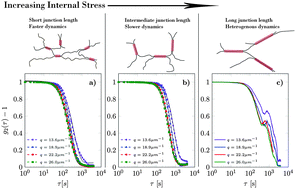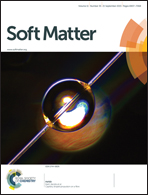Internal stress drives slow glassy dynamics and quake-like behaviour in ionotropic pectin gels†
Abstract
Frustrated, out-of-equilibrium materials have been of considerable interest for some time and continue to be some of the least understood materials. Recent measurements have shown that many gelled biopolymer materials display slow dynamics on timescales greater than one second, that are not accessible with typical methods, and are characteristic of glassy trapped systems. In this study we have controlled the fine structure of the anionic polysaccharide pectin in order to construct a series of ionotropic gels having differing binding energies between the constituent chains, in an attempt to further understand the slow dynamical processes occurring. Using multi-speckle light scattering techniques it is shown that the slow dynamics observed in these gelled systems are stress-driven. As the binding lengths, and thus the binding energies, of the junction zones between the polymer chains in these networks increase the long-time dynamics initially slow, as might be expected, until a critical level of internal stress is reached upon which the dynamics increase significantly, with gentle creaking punctuated by localised stress-relieving quakes.


 Please wait while we load your content...
Please wait while we load your content...